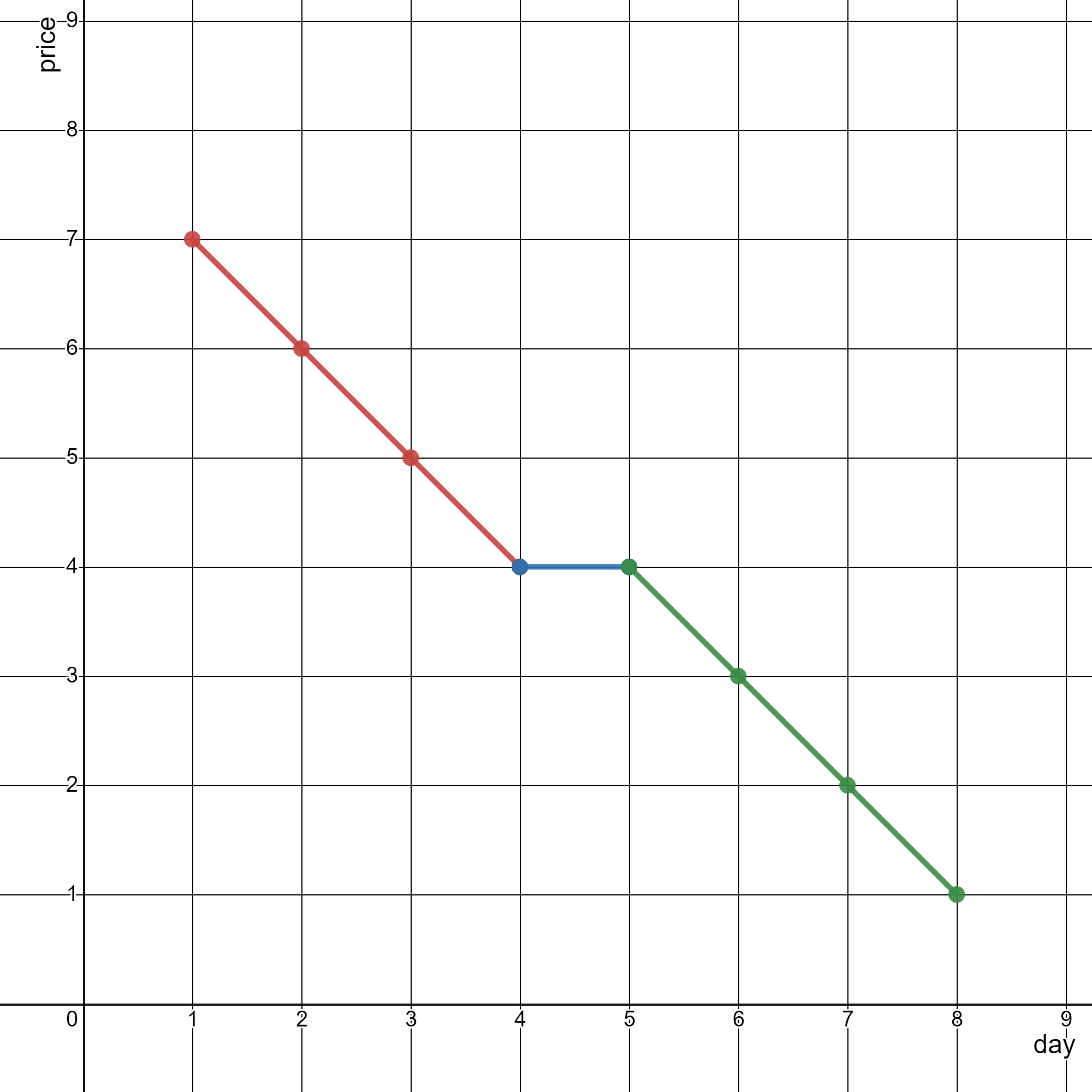Welcome to Subscribe On Youtube
Formatted question description: https://leetcode.ca/all/2280.html
2280. Minimum Lines to Represent a Line Chart
- Difficulty: Medium.
- Related Topics: Array, Math, Geometry, Sorting, Number Theory.
- Similar Questions: Max Points on a Line, Minimum Number of Lines to Cover Points.
Problem
You are given a 2D integer array stockPrices where stockPrices[i] = [dayi, pricei] indicates the price of the stock on day dayi is pricei. A line chart is created from the array by plotting the points on an XY plane with the X-axis representing the day and the Y-axis representing the price and connecting adjacent points. One such example is shown below:

Return the **minimum number of lines needed to represent the line chart**.
Example 1:

Input: stockPrices = [[1,7],[2,6],[3,5],[4,4],[5,4],[6,3],[7,2],[8,1]]
Output: 3
Explanation:
The diagram above represents the input, with the X-axis representing the day and Y-axis representing the price.
The following 3 lines can be drawn to represent the line chart:
- Line 1 (in red) from (1,7) to (4,4) passing through (1,7), (2,6), (3,5), and (4,4).
- Line 2 (in blue) from (4,4) to (5,4).
- Line 3 (in green) from (5,4) to (8,1) passing through (5,4), (6,3), (7,2), and (8,1).
It can be shown that it is not possible to represent the line chart using less than 3 lines.
Example 2:

Input: stockPrices = [[3,4],[1,2],[7,8],[2,3]]
Output: 1
Explanation:
As shown in the diagram above, the line chart can be represented with a single line.
Constraints:
-
1 <= stockPrices.length <= 105 -
stockPrices[i].length == 2 -
1 <= dayi, pricei <= 109 -
All
dayiare distinct.
Solution (Java, C++, Python)
-
class Solution { public int minimumLines(int[][] stockPrices) { if (stockPrices.length == 1) { return 0; } Arrays.sort(stockPrices, (a, b) -> a[0] - b[0]); // multiply with 1.0 to make it double and multiply with 100 for making it big so that // difference won't come out to be very less and after division it become 0. // failing for one of the case without multiply 100 double lastSlope = (stockPrices[1][1] - stockPrices[0][1]) * 100 / ((stockPrices[1][0] - stockPrices[0][0]) * 1.0); int ans = 1; for (int i = 2; i < stockPrices.length; i++) { double curSlope = (stockPrices[i][1] - stockPrices[i - 1][1]) * 100 / ((stockPrices[i][0] - stockPrices[i - 1][0]) * 1.0); if (lastSlope != curSlope) { lastSlope = curSlope; ans++; } } return ans; } } ############ class Solution { public int minimumLines(int[][] stockPrices) { Arrays.sort(stockPrices, (a, b) -> a[0] - b[0]); int dx = 0, dy = 1; int ans = 0; for (int i = 1; i < stockPrices.length; ++i) { int x = stockPrices[i - 1][0], y = stockPrices[i - 1][1]; int x1 = stockPrices[i][0], y1 = stockPrices[i][1]; int dx1 = x1 - x, dy1 = y1 - y; if (dy * dx1 != dx * dy1) { ++ans; } dx = dx1; dy = dy1; } return ans; } } -
class Solution: def minimumLines(self, stockPrices: List[List[int]]) -> int: stockPrices.sort() dx, dy = 0, 1 ans = 0 for (x, y), (x1, y1) in pairwise(stockPrices): dx1, dy1 = x1 - x, y1 - y if dy * dx1 != dx * dy1: ans += 1 dx, dy = dx1, dy1 return ans ############ # 2280. Minimum Lines to Represent a Line Chart # https://leetcode.com/problems/minimum-lines-to-represent-a-line-chart/ class Solution: def minimumLines(self, stock: List[List[int]]) -> int: n = len(stock) if n == 1: return 0 stock.sort(key = lambda x: x[0]) dx = stock[0][0] - stock[1][0] dy = stock[0][1] - stock[1][1] res = 1 for index in range(2, n): x, y = stock[index] dx1 = stock[index - 1][0] - stock[index][0] dy1 = stock[index - 1][1] - stock[index][1] if dx1 * dy != dx * dy1: res += 1 dx = dx1 dy = dy1 return res -
class Solution { public: int minimumLines(vector<vector<int>>& stockPrices) { sort(stockPrices.begin(), stockPrices.end()); int dx = 0, dy = 1; int ans = 0; for (int i = 1; i < stockPrices.size(); ++i) { int x = stockPrices[i - 1][0], y = stockPrices[i - 1][1]; int x1 = stockPrices[i][0], y1 = stockPrices[i][1]; int dx1 = x1 - x, dy1 = y1 - y; if ((long long) dy * dx1 != (long long) dx * dy1) ++ans; dx = dx1; dy = dy1; } return ans; } }; -
func minimumLines(stockPrices [][]int) int { ans := 0 sort.Slice(stockPrices, func(i, j int) bool { return stockPrices[i][0] < stockPrices[j][0] }) for i, dx, dy := 1, 0, 1; i < len(stockPrices); i++ { x, y := stockPrices[i-1][0], stockPrices[i-1][1] x1, y1 := stockPrices[i][0], stockPrices[i][1] dx1, dy1 := x1-x, y1-y if dy*dx1 != dx*dy1 { ans++ } dx, dy = dx1, dy1 } return ans } -
function minimumLines(stockPrices: number[][]): number { const n = stockPrices.length; stockPrices.sort((a, b) => a[0] - b[0]); let ans = 0; let pre = [BigInt(0), BigInt(0)]; for (let i = 1; i < n; i++) { const [x1, y1] = stockPrices[i - 1]; const [x2, y2] = stockPrices[i]; const dx = BigInt(x2 - x1), dy = BigInt(y2 - y1); if (i == 1 || dx * pre[1] !== dy * pre[0]) ans++; pre = [dx, dy]; } return ans; }
Explain:
nope.
Complexity:
- Time complexity : O(n).
- Space complexity : O(n).